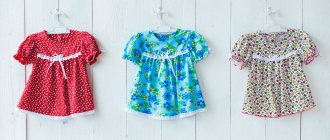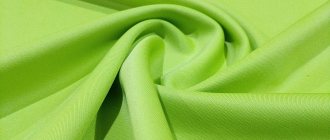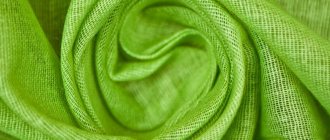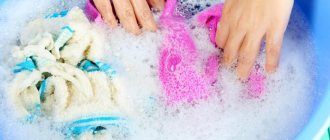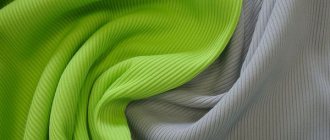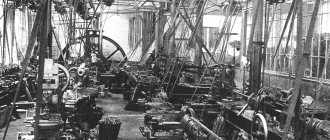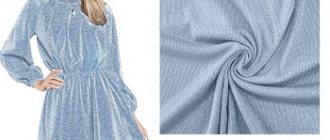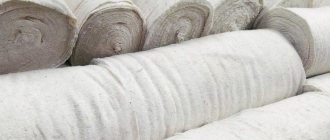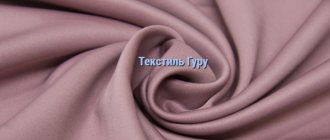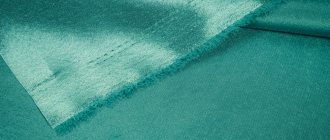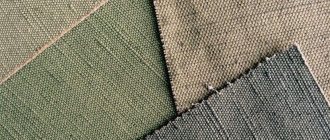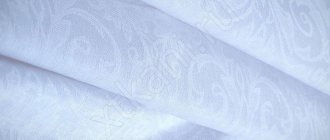Among the huge number of fabrics made from natural materials, interlock stands apart. What kind of interlock fabric is it, what is it good for? In this article you will find descriptions and reviews of interlock fabric, as well as useful information on caring for it.
History and description
So, interlock fabric - what kind of fabric is it? The first thing you need to know is that this is a completely natural material of the highest quality. Foam is the best fabric among all the fabrics called Interlock. You can see what this knitwear looks like in the photo.
When raw cotton is processed, the fibers are produced in varying lengths and qualities. So, the longest fibers, which are subjected to the most careful processing and polishing, are used in the manufacture of foam interlock fabric (100% cotton), which is responsible for its unsurpassed quality. After careful sanding, the cotton fibers are completely free of any flaws; there are no lint or tiny knots to be found. That is why the material turns out to be thin, but at the same time very durable, smooth and silky to the touch.
Read also: “Interlock fabric: description and reviews.”
By the way, you can read about another material - Pike, also made of 100% cotton, but with a relief structure, in another of our articles.
The cost of a meter of this knitwear is from 480 rubles.
Let's look at the suit:
Advantages and disadvantages
In addition to the aesthetic appearance and excellent quality, regular or compact interlock foam has a number of additional advantages:
- thanks to selected raw materials and a special knitting method, the material, despite all its delicacy, is very durable;
- Things sewn from this material retain their shape perfectly, although due to their completely natural composition, they do not stretch as well as mixed knitwear;
- the material practically does not form pilling or puffs even when worn for a long time, the clothes are durable;
- the delicate material does not require maintenance, the rules are minimal, and if carefully followed, the item will last for years;
- the highest level of environmental friendliness - textiles do not cause any irritation, allow the skin to breathe freely, retain heat and perfectly absorb moisture.
Among the disadvantages, one can highlight only the relatively high cost, as well as a low degree of elasticity, especially in comparison with mixed fabrics. If washing conditions are not followed, clothes may shrink significantly in length.
Properties
- Extraordinarily durable material. This property is ensured by the best raw materials and special knitting technique.
- The clothes keep their shape perfectly. Of course, knitwear is not as elastic as its counterparts, in the manufacture of which artificial materials are used, but it still stretches and then quickly takes its original shape. For those who are interested in cotton materials with the addition of synthetic fibers, in our other article you can read about the interesting material cashcorse, where, in addition to cotton, a small amount of lycra is used.
- Products made from this knitwear can be worn for a very long time; you will get tired of the item before it becomes unusable. Puffs and pilling are anything but signs of interlock knitwear
- The material does not require special care, it is enough to wash things as recommended by the manufacturer (however, about the features of care - a little lower)
- What is interlock fabric if not one of the most environmentally friendly materials - this fabric will not provoke allergic reactions or cause irritation. In addition, it perfectly allows air to pass through and absorbs moisture;
More on the topic:
- Size chart for children's clothing by age and height;
- US children's sizes on Aliexpress (table);
- Sizes of newborns by month (table);
Production technology
The fibers of the future fabric are first treated with paraffin and a special solution to smooth them and give them strength. To produce fabric, special equipment with fonts placed at an angle is used. Intertwined with special loops, the fibers turn into fabric.
To make striped and checkered fabrics, fibers of different colors are used. The threads are dyed using the printing method, the colors are applied separately. To apply a pattern to colored material, use direct dyeing on the selected area.
The more synthetics in the composition, the worse the fabric allows air and water to pass through. Therefore, before buying interlock, you need to carefully read the composition of the fabric.
Application
What do they sew from interlock foam? First of all, these are things for every day. Pajamas, dressing gowns, home clothes - all this will be convenient and comfortable. In addition, the item, even with daily wear, will last a very long time.
An excellent choice is sportswear made from this knitwear.
And, of course, children's clothing. What else to dress up a baby in, if not in rompers and vests made of eco-friendly and hypoallergenic material.
Additionally for mothers, the article is “Cooler material: what is it, reviews.”
Video:
Types of interlock
According to international markings, there are three types of interlock depending on the quality of grinding:
- Peña is a fabric that is produced using the best long threads. The material is perfectly smooth, thin, a little silky to the touch, but quite durable. It practically does not wrinkle, does not wrinkle, and retains its shape for a long time. Retains heat well. Provides free air circulation.
- Ring (carde) - made from medium-length cotton threads, as a result the fabric is slightly looser than foam. Good performance is noted. The matter is quite dense and warm.
- Open End - knitted from the shortest and loosest threads. The resulting knitwear has a lot of fibers - the tips of these same threads. In terms of cost, oppened is the most inexpensive in its class.
Care
Here are a few basic rules that will allow your item to last as long as possible:
- Wash at a temperature of no more than 40 degrees
- Machine washable on delicate cycle only. Of course you can wash it by hand
- It is not recommended to squeeze the products too hard
- The powder used must not contain bleach or bleach.
- You need to iron things made from foam from the inside out
- Store neatly folded or on hangers
Read about what ribana with lycra is in another article.
Rules for caring for interlock products
In order for clothes to maintain their appearance longer, they need to be properly cared for. Usually, the manufacturer leaves its care recommendations on a special label for each item. It is very important to familiarize yourself with this information so as not to spoil the material.
The basic rules for careful care of interlock products are:
- temperature regime – no higher than 40°C;
- hand wash or delicate machine wash;
- low spin speed;
- washing powder without chlorine bleaches;
- ironing the product from the wrong side;
- drying things in a dark, well-ventilated place;
- For storage, items must be neatly folded or hung on hangers.
Reviews
Those who are interested in what kind of interlock foam fabric can read reviews from people who have already dealt with this material.
Angelina, 27 years old “I bought an interlock envelope for my baby’s discharge (the envelope itself, as well as a cap, a vest, and rompers). When you touch this material, you immediately understand that the child will be comfortable in clothes made from it. Moreover, cotton fabric will never cause allergies, which is also very important for a newborn.”
Oleg, 23 years old “I play sports a lot, and I don’t see any other clothes for myself except those made from this fabric. Any knitwear is pleasant to the body, but this one allows air to pass through, absorbs moisture, and is also very durable and can survive many washes.”
For all the materials for children, read the link.
What kind of fabric is this
Interlock foam is a classic cotton fabric produced to high standards. But in order to better understand this issue, it is worth considering it from different angles.
Production
When sewing, erasers are used, connected on the reverse sides with a satin weave. The production itself occurs by interweaving threads that are bent into loops. Before sewing, the threads are treated with a special emulsion or paraffin. This gives strength and smoothness. Multi-colored options are obtained by using threads of different colors. Painting is carried out only on specific required areas using the printed method.
You can learn about the types of terry fabric in this material.
Sometimes this species is called dvulastic. It received this nickname because it is completely identical on both sides, that is, it has no reverse.
Texture and density
The texture is soft, pleasant to the body, smooth, in contrast to the rough texture of crepe knitwear. Moreover, it is pleasant to touch it both from the outside and from the inside. To the touch the fabric can be confused with silk, but there is no characteristic shine.
The density is high, given the thinness and lightness, it is 180-330 grams per square meter. A closer look reveals a tight fit of threads arranged in a herringbone pattern.
Material properties, quality
The high level of raw materials and sewing is the reason that the fabric has a large list of positive properties. These include:
- Wear resistance. Withstands use well and is resistant to abrasion. The structure of the fabric and the quality of the threads ensure a good appearance without puffs, holes or pilling.
- Persistence. Even after being stretched, things can return to their original shape. High-quality Dior knitwear can quickly return the shape of a product.
- Hygroscopicity. The material perfectly absorbs moisture and releases it.
- Breathability. Interlock provides good air exchange, which is especially important for an active lifestyle.
- Thermal insulation. These clothes are quite comfortable in the cold season.
- Color fastness. The fabric does not fade or fade.
- Environmentally friendly. Natural materials are used to make interlock.
- Safety. Natural fabric is breathable, does not cause irritation, absorbs moisture, and is suitable for delicate and sensitive skin, especially children's skin.
- Softness. The fabric is pleasant to the touch, smooth and elastic (can stretch), even after washing.
- Easy to care for. It is enough to follow the recommendations on the product label.
There are many advantages, but there are also some negative points. This includes:
- high probability of product shrinkage;
- due to their density and heat resistance, interlock items are not suitable for hot summers;
- there is minimal elasticity.
Read about knitwear, which consists of 100% polyester - fukra, in this article.
Difference from other materials
It is often confused with the following fabrics:
- Footer – smooth or brushed on the inside. Lycra, wool, and polyester are added to it. Footer and interlock, difference: made of two or three threads, footer is denser and warmer than double elastic. But it stretches worse and deforms more easily.
- Cashkorse has the same density. Composition – 100% cotton, or add up to 10% lycra, polyester, elastane. When knitting, alternate purl and knit stitches 2x2 or 3x3. The texture is knitted, smooth. The cost is between a cooler and a double-last.
- Kulirka or interlock, which is denser? The cooler is thinner, 145-180 g/m2. m. Differences between a kulirka and a double-strap: on the outside of the kulirka (suprema), a braided braid is obtained. The reverse side looks like brickwork. It costs less.
Which is better, cooler or interlock: it depends on the specific product and season. Supreme is suitable for the warm season, for making delicate items, for children and adults. Warm knitwear makes you feel more comfortable in the cold.
Manufacturing
Read about: crepe de Chine fabric: when femininity is in fashion.
According to the knitting method, interlock refers to double knitwear. The fabric is made by weaving threads. They continuously bend into loops, connecting with each other. The loop is the basis of knitting. Its main elements are the broach and the skeleton. The latter has looped sticks and arcs. Loop rows are elements located horizontally, the columns have a vertical orientation.
The material belongs to derivative cross-knitted weaves. This look is obtained by combining two or more main weaves of the same type. Thanks to this combination, the derived type has a higher density. Loop columns have smaller spaces. This has a positive effect on the characteristics of the final product. It has less horizontal extensibility, greater density, and also does not unravel so much when the threads break.
It is a combination of two erasers that are connected from the inside out. As a result, it is impossible to distinguish the inner and outer sides of this canvas. To knit an eraser, alternate knit stitches with purl stitches. This combination can be different:
- through one column 1+1;
- through two columns 2+2;
- two knit and one purl 2+1.
What they sew, where they use it
Due to its many advantages, interlock is widely used in sewing various textiles.
- Children's clothing, diapers, booties, hats.
- All types of sports jersey. Suits, hoodies, sweatshirts, pants, T-shirts.
- Home textiles - bathrobes, pajamas, shirts, T-shirts.
- Underwear and bed linen. Accessories for mattresses.
- Peñe type fabric is used to sew high-quality clothes.
